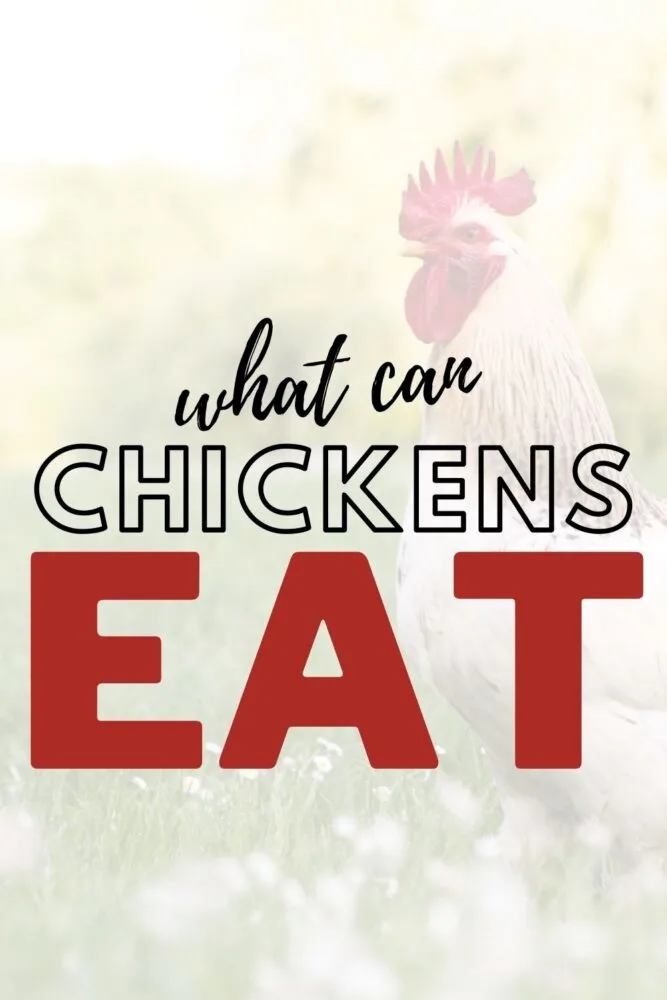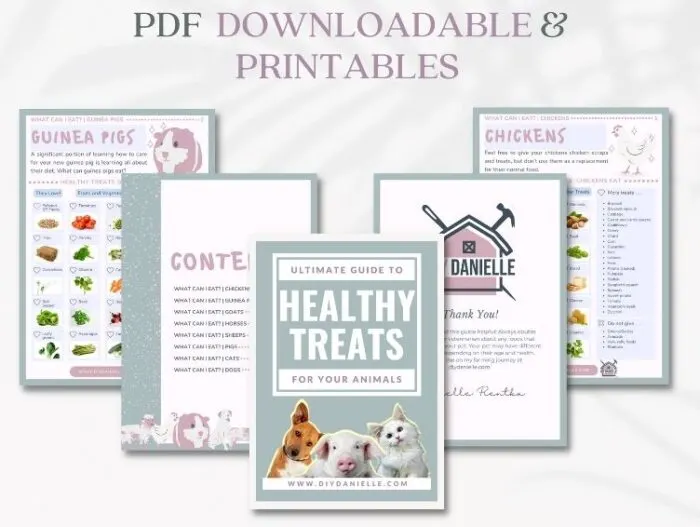What can chickens eat? Here is a guide to what chickens can- and can’t!- eat safely. Your feed choices can impact their health and egg taste.
If you’re a new chicken owner you’ve likely seen other people’s chickens happily pecking away at their kitchen scraps. You’re ready to treat your chickens, but what foods are safe to give them?
While the main component of a chicken’s diet should be a high-quality commercial poultry feed, giving them scraps and treats every few days (or even with every meal) is a great way to add variety and interest to their diet. It’s also a great way to reduce kitchen waste.
Since chickens are omnivores, they can safely eat most vegetables and fruits, nuts, and even some meat. Today I’m going to guide you through a full list of what your chickens can and can’t eat so that you can make sure you are giving your chickens safe and nutritious treats.
This post may contain affiliate links which may earn me commissions should you click through them and take certain actions. As an affiliate for Amazon, Cricut, xTool, Home Depot, and other sites, I earn from qualifying purchases. Please DIY carefully. View my full legal disclosures here.
Please read the whole post so you don’t miss any important information!
What Should Chickens Eat?
Commercial poultry feed provides chickens with all the nutrients they need to stay healthy and produce healthy eggs, so around 90% of their diet should be poultry feed. In other words, feel free to give your chickens chicken scraps and treats, but don’t use them as a replacement for their normal food.
What vegetables can chickens eat?
One thing that chickens love, and we humans often have scraps of, is vegetables. There is a long list of vegetables that it is safe for chickens to eat, including:
- Artichoke
- Asparagus (can alter egg taste)
- Beets
- Bell pepper
- Bok choy
- Broccoli (limit the amount given)
- Brussels sprouts (limit the amount given)
- Cabbage (limit the amount given)
- Carrot and carrot greens
- Cauliflower (limit the amount given)
- Celery
- Chard
- Corn
- Cucumber
- Kale
- Lettuce
- Peas
- Potato (cooked)
- Pumpkin
- Radish
- Spaghetti squash
- Spinach
- Sweet potato
- Tomato
- Vegetable peels (although not all, which we will look at below)
- Zucchini
Tip: If you want your chickens to produce eggs with darker, richer yolks, try giving them dark, leafy greens!
What fruits can chickens eat?
Chickens also love fruit. Due to the higher sugar content of fruits, they should be given in moderation, but some great fruity treats for your chickens are:
- Apple (with the seeds removed as they contain cyanide)
- Apricot (with the pit removed)
- Banana (both the fruit and peel can be given)
- Blueberries
- Cantaloupe
- Cherries (with the pit removed)
- Grapes
- Kiwi
- Mango
- Melon
- Peach (with the pit removed)
- Pear
- Pineapple (limit the amount given)
- Plum (with the pit removed)
- Pomegranate
- Raisins (limit the amount given)
- Strawberries
- Watermelon (this makes a particularly great treat for added hydration during hot weather)
What other foods can chickens eat?
As well as fruits and vegetables, there are several other foods you can give to your chickens as a treat, such as:
- Almonds
- Basil (this herb will support your chickens’ immune system)
- Bread (only in small amounts as it contains very little nutritional value, and be sure to remove any mold)
- Cheese (in moderation as chickens are unable to process higher quantities of dairy)
- Cilantro
- Cooked beans (not fava beans)
- Cooked meats (can provide a good source of occasional protein, making sure to cut into small pieces before feeding and avoid pure fatty bits – this can include your Thanksgiving turkey carcass!)
- Cooked pasta (in moderation)
- Cooked rice
- Ginger (a good antioxidant and can help to reduce stress)
- Lavender
- Mint
- Oatmeal
- Oregano (this herb will support your chickens’ immune system)
- Parsley
- Popcorn (popped or un-popped, unsalted and unbuttered)
- Quinoa (washed or cooked, otherwise the saponins it contains are indigestible for poultry)
- Shelled and unsalted nuts (in moderation, chopped into small pieces)
- Sunflower seeds (particularly good for molting chickens)
- Thyme
- Wheat
What Can’t Chickens Eat?
Since the list of things chickens can eat is extensive, the most important thing to take note of is what chickens can’t eat, due to a health or life risk.
A general rule is to remember that if something isn’t healthy for you, it won’t make a good treat for your chickens. Thankfully, chickens are inclined to avoid things that will be harmful to them, but you must avoid giving them anything potentially harmful.
Toxic foods include:
- Anything high in fat or salt
- Avocado – all parts of an avocado contain a fungicidal toxin known as persin that can be fatal to chickens
- Broad beans (also known as fava or faba beans)
- Caffeine/coffee grounds – this will cause an increase in heart rate, potentially leading to complications
- Chocolate – the substance known as theobromine is toxic to birds as well as many other animals
- Citrus fruits – there is some debate about whether citrus fruits are safe for chickens, but a few sources say that feeding citrus fruits can lead to soft eggshells due to inhibiting calcium absorption, so it’s best to avoid them
- Garlic (in large quantities) – this will make your chickens’ eggs taste gone-off, though a little can be good for their health
- Leaves of the nightshade family – this includes eggplant, pepper, potato, and tomato plants, as they are all toxic
- Onion – although in small quantities it can just change the flavor of your chickens’ eggs, in large quantities it can lead to anemia
- Processed foods – these may contain unnatural chemicals and oils
- Rancid or spoiled food – the bacteria and mold that have had time to grow will be very harmful (and it’s unlikely they’ll eat them in the first place, so you’ll likely just have a mess to clear up)
- Raw meat – may have harmful bacteria
- Raw potato and peel, particularly if it is green – this contains solanine which is toxic (sweet potato is from a different family, so those skins are safe)
- Rhubarb – the anthraquinones may have a laxative effect and the oxalic acid in the leaves is highly toxic
- Uncooked beans – raw beans contain hemagglutinin which can prevent digestion
- Uncooked rice – this will absorb the moisture in your chickens’ stomachs and swell, causing blockages within the digestive system
- Wild mushrooms – cannot be sure that they will be safe for consumption
- Xylitol (a type of artificial sweetener found in chewing gum and some other products)
FREE Ways to Feed Your Chickens
Before you break the bank buying up the produce aisle for chicken treats, however, there are better ways to improve your chickens’ diet.
- Ask the local grocery store if they’ll give you any produce they’re going to throw away.
- When you weed your garden, save the weeds to give to your chickens. They love pecking through the weeds to find bugs or to eat the plants.
- Give them your kitchen waste! Nobody can pick a corn of cob clean like a chicken… not even you! Mine love finishing off watermelon, cantaloupe, and corn in particular. They’ll even pick a rotisserie chicken bare.
- Garden waste, likewise, is excellent for chickens. They love eating fruits and veggies that didn’t past muster to go into the refrigerator. They don’t care if the fruit or veggie has a worm in it.
- Eggs: I said it. You can scramble or cook them, or just crack them for them. Some people say that if you throw them raw eggs, they’ll learn to eat their eggs. This is possible. I have a Best Egg nest box so most of our eggs roll out of the chickens’ reach.
- Free range: Let the chickens free range in your yard or woods. They’ll till up the soil, eat bugs (even ticks and spiders!), eat vegetation. Sometimes they’ll even eat a small mouse or snake.
I can’t free range on my property due to a very aggressive fox population, but instead I use a chicken moat garden made with electric fencing to give chickens access to bugs, grass and weeds near my garden. In the off season, they’re allowed into my garden to till the soil.
Free ranging chickens or pasture raising chickens greatly reduces how much feed they’ll need. They get a more diverse diet and they get the joy of being able to eat what they want, when they want it.
Safe Chicken Treats
Chicken Treats
Making sure to avoid harmful foods and sticking to the 10% rule is crucial when giving your chickens treats to supplement their diet. As long as you are starting with a high-quality poultry feed to provide your chickens with all the nutrients they need, any safe treats you give them will keep them happy.
Just make sure you don’t overindulge them, as much as you may want to!
I have a printable bundle of foods for different farm animals and household pets. Subscribers can get the printable FREE by signing up below!
Please share and pin this post! If you make this project, share it in our Stuff Mama Makes Facebook Group. We have regular giveaways for gift cards to craft stores. You can also tag me on Instagram @doityourselfdanielle; I love seeing everything you make!









